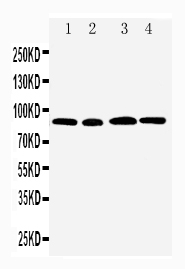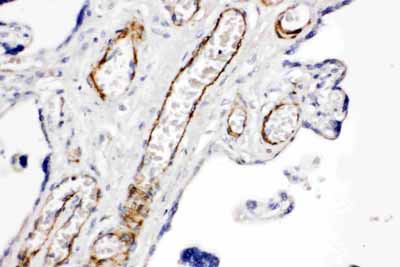Anti-CD168 Antibody
- SPECIFICATION
- CITATIONS
- PROTOCOLS
- BACKGROUND

Application
| WB, IHC-P |
|---|---|
| Primary Accession | O75330 |
| Host | Rabbit |
| Reactivity | Human |
| Clonality | Polyclonal |
| Format | Lyophilized |
| Description | Rabbit IgG polyclonal antibody for Hyaluronan mediated motility receptor(HMMR) detection. Tested with WB, IHC-P in Human. |
| Reconstitution | Add 0.2ml of distilled water will yield a concentration of 500ug/ml. |
| Gene ID | 3161 |
|---|---|
| Other Names | Hyaluronan mediated motility receptor, Intracellular hyaluronic acid-binding protein, Receptor for hyaluronan-mediated motility, CD168, HMMR, IHABP, RHAMM |
| Calculated MW | 84100 MW KDa |
| Application Details | Immunohistochemistry(Paraffin-embedded Section), 0.5-1 µg/ml, Human, By Heat Western blot, 0.1-0.5 µg/ml, Human |
| Subcellular Localization | Cell surface. Cytoplasm . |
| Protein Name | Hyaluronan mediated motility receptor |
| Contents | Each vial contains 5mg BSA, 0.9mg NaCl, 0.2mg Na2HPO4, 0.05mg Thimerosal, 0.05mg NaN3. |
| Immunogen | A synthetic peptide corresponding to a sequence at the C-terminus of human CD168(706-724aa KEGNTNCYRAPMECQESWK). |
| Purification | Immunogen affinity purified. |
| Cross Reactivity | No cross reactivity with other proteins |
| Storage | At -20˚C for one year. After r˚Constitution, at 4˚C for one month. It˚Can also be aliquotted and stored frozen at -20˚C for a longer time.Avoid repeated freezing and thawing. |
| Name | HMMR |
|---|---|
| Synonyms | IHABP, RHAMM |
| Function | Receptor for hyaluronic acid (HA) (By similarity). Involved in cell motility (By similarity). When hyaluronan binds to HMMR, the phosphorylation of a number of proteins, including PTK2/FAK1 occurs. May also be involved in cellular transformation and metastasis formation, and in regulating extracellular-regulated kinase (ERK) activity. May act as a regulator of adipogenisis (By similarity). |
| Cellular Location | Cell surface {ECO:0000250|UniProtKB:Q00547}. Cytoplasm {ECO:0000250|UniProtKB:Q00547}. Cytoplasm, cytoskeleton, spindle {ECO:0000250|UniProtKB:Q00547} |
| Tissue Location | Expressed in testis (PubMed:22965910). Expressed in the breast (PubMed:8890751). |

Thousands of laboratories across the world have published research that depended on the performance of antibodies from Abcepta to advance their research. Check out links to articles that cite our products in major peer-reviewed journals, organized by research category.
info@abcepta.com, and receive a free "I Love Antibodies" mug.
Provided below are standard protocols that you may find useful for product applications.
Background
HMMR, Hyaluronan-mediated motility receptor, is a protein which in humans is encoded by the HMMR gene. RHAMM was originally discovered as a soluble protein that altered migratory cell behavior and bound to hyaluronan, HMMR is less well studied than the main hyaluronan(HA) receptor, CD44. In contrast to CD44 and other cell-surface receptors which contain the classical membrane spanning domain and signal sequence for secretion from the endoplasmic reticulum/Golgi complex, HMMR does not contain a membrane spanning domain nor does the mRNA transcript contain a signal sequence. HMMR normally is localized inside the cell and is only release by certain, poorly defined stimuli. The transport of HMMR to the extracellular space still is unclear but may involve transport channels or proteins, flippase activity, or exocytosis. Intracellularly, HMMR associates with microtubules and, working with BRCA1 and BARD1, plays a role in the regulation of mitosis. Extracellularly, HMMR associates with CD44, and upon binding to HA, activates intracellular signaling pathways. Variants of HMMR caused by alternative splicing have been observed, but not thoroughly studied.
If you have used an Abcepta product and would like to share how it has performed, please click on the "Submit Review" button and provide the requested information. Our staff will examine and post your review and contact you if needed.
If you have any additional inquiries please email technical services at tech@abcepta.com.













 Foundational characteristics of cancer include proliferation, angiogenesis, migration, evasion of apoptosis, and cellular immortality. Find key markers for these cellular processes and antibodies to detect them.
Foundational characteristics of cancer include proliferation, angiogenesis, migration, evasion of apoptosis, and cellular immortality. Find key markers for these cellular processes and antibodies to detect them. The SUMOplot™ Analysis Program predicts and scores sumoylation sites in your protein. SUMOylation is a post-translational modification involved in various cellular processes, such as nuclear-cytosolic transport, transcriptional regulation, apoptosis, protein stability, response to stress, and progression through the cell cycle.
The SUMOplot™ Analysis Program predicts and scores sumoylation sites in your protein. SUMOylation is a post-translational modification involved in various cellular processes, such as nuclear-cytosolic transport, transcriptional regulation, apoptosis, protein stability, response to stress, and progression through the cell cycle. The Autophagy Receptor Motif Plotter predicts and scores autophagy receptor binding sites in your protein. Identifying proteins connected to this pathway is critical to understanding the role of autophagy in physiological as well as pathological processes such as development, differentiation, neurodegenerative diseases, stress, infection, and cancer.
The Autophagy Receptor Motif Plotter predicts and scores autophagy receptor binding sites in your protein. Identifying proteins connected to this pathway is critical to understanding the role of autophagy in physiological as well as pathological processes such as development, differentiation, neurodegenerative diseases, stress, infection, and cancer.



